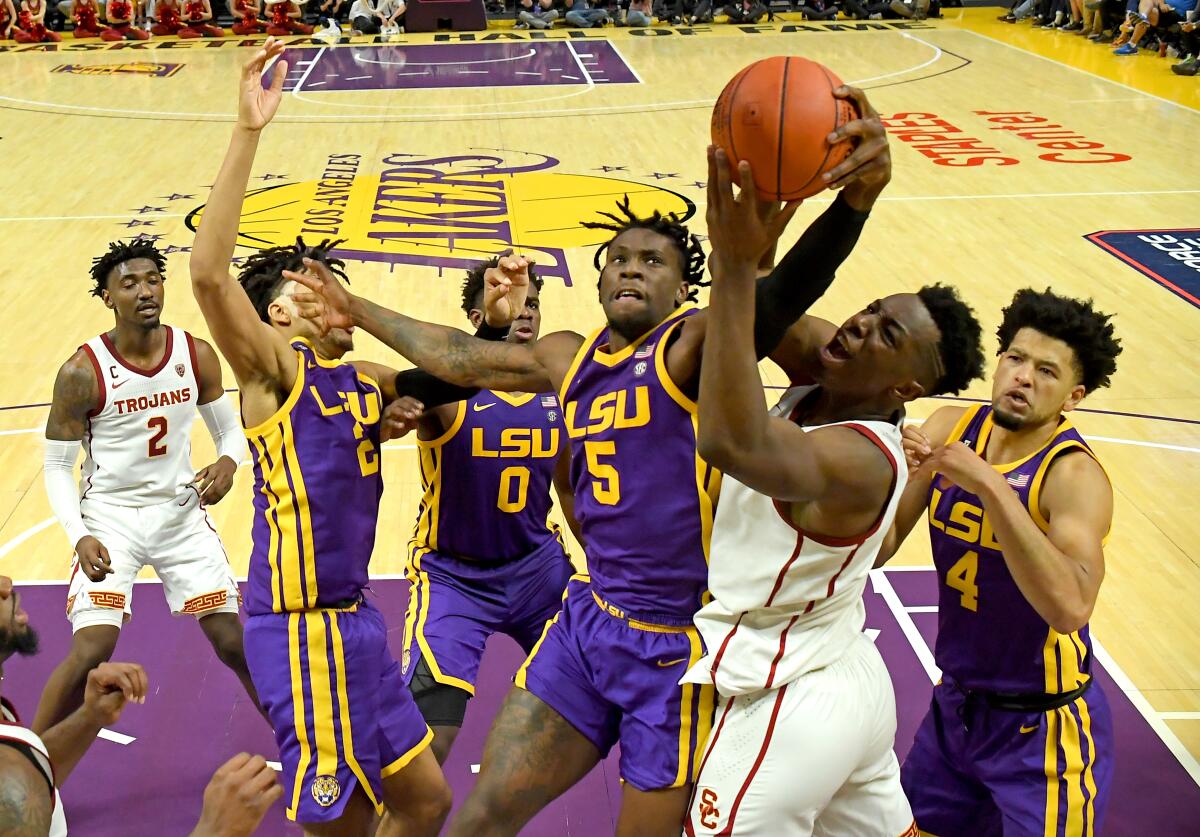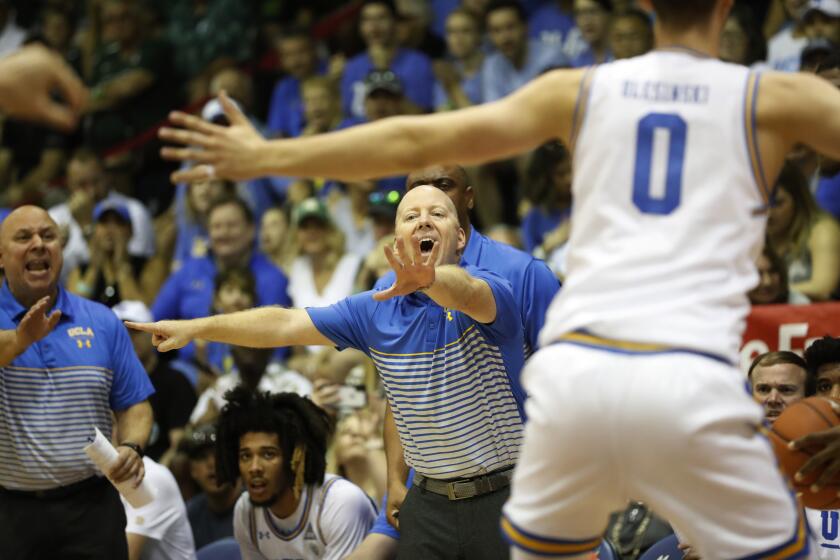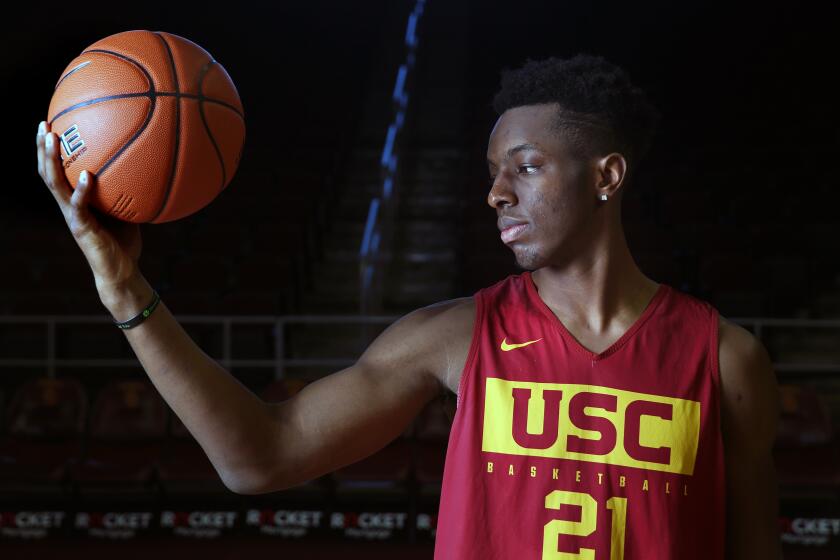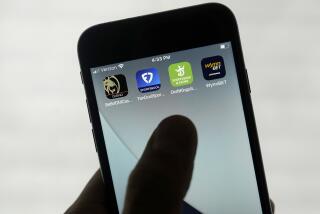Here’s what to look for when betting college basketball

- Share via
UCLA and USC begin Pac-12 play Thursday night on the road in Washington. UCLA plays the Huskies at 7 p.m. and USC goes against the Cougars at 7:30 p.m. The L.A. schools flip opponents this weekend.
College basketball betting increases dramatically at the beginning of any calendar year. Football is winding down, and gamblers need action. Some of you may take occasional excursions to Nevada to bet the Pac-12, other conferences or even with nationally televised games. So, let’s review some handicapping fundamentals.
The first thing is that all teams play similar league schedules. Everyone starts over and handicappers and bettors can throw out polluted perceptions from pre-conference schedules that were too easy (cupcakes on parade) or too difficult (made-for-TV testers).
Some leagues play full double round-robin rotations. Others are too big for that, but still play so many games that “strength of schedule” within the league is extremely similar. That makes scoring margins, team and player stats great indicators of quality.
UCLA need to rediscover the early-season defense that propelled it to a 4-0 start. The Bruins open Pac-12 basketball action at Washington on Thursday.
Schedule strength ratings usually settle within four or five games of league play. That doesn’t seem like a huge sample size. And nobody should irresponsibly bet large amounts because of what they see in a handful of games. But observers will see the general picture come into focus that quickly, even if they completely ignored the season until that point.
Longtime VSiN.com visitors know we emphasize these team stat categories in college basketball: offensive and defensive efficiency (scoring adjusted for pace), turnover percentage on both sides of the floor, and rebound percentage. If you have a favorite conference, you should log these stats on a game-by-game basis. That’s a manageable task for one (or two) leagues because teams typically play just two games a week.
If you’re not comfortable with advanced analytic stats, simply using standard old-school box scores to log two-point shooting, three-point shooting, rebound differential, and turnover differential will get you there. You’ll recognize team strengths and weaknesses quickly.
Oneyka Okongwu has quickly become a force for USC’s basketball program. But the freshman forward remains level-headed, always mindful of his brother who died in 2014.
Should you study individual players? This is generally overrated in game broadcasts, where announcers want to focus on star power to generate narratives. There are certainly teams where one main guy is “the straw that stirs the drink.” Nothing wrong with looking for that workhorse, then betting against his team when he’s hurt or worn down. (You’ll learn to recognize head coaches who overemphasize a workhorse at the expense of building a complete team.)
You are probably wondering about the value of home-court advantage in conference play. The market typically uses about three points as a general rule. Some professional gamblers only use 2.5 points in geographically compact leagues. Others emphasize “road-court disadvantage” more for very young teams lacking experience.
TV broadcasts that focus on crowd size are prone to exaggerate the impact of home court. Boisterous student bodies don’t push the number much higher than three. Empty arenas may not knock it down. Much of the “advantage” for hosts involves travel fatigue and unfamiliarity with shooting backdrops.
As of now, UCLA and USC enter league play as losing bets. Each is 6-7 against the spread. Bettors pay a 10% surcharge on losing bets, meaning those records represent six wins and 7.7 losses in real money terms (minus 1.7 units).
Over/under bettors are keeping an eye on the low scoring tendency of USC games compared to market expectations. Nine of the Trojans’ 13 games have gone under the posted total.

NFL Playoff Notes
Last week’s shocking loss by the New England Patriots to the Miami Dolphins caused some shuffling on the Super Bowl futures board. The Patriots dropped to No. 6 on the ladder after spending the season as one of the favorites.
Here’s a look at a composite of posted odds from sportsbooks: Baltimore 9/4, San Francisco 4/1, Kansas City 9/2, New Orleans 6/1, Green Bay 8/1, New England 12/1, Seattle 25/1, Philadelphia 33/1, Houston 33/1, Buffalo 50/1, Tennessee 50/1.
In this weekend’s wild-card games, pro bettors have shown a clear preference for Buffalo at +3 in Houston. They will take the Bills whenever the key number is on the board. Pro bettors also showed an early preference for Tennessee +5.5 at New England, suggesting interest on the Titans at that line or higher. Early informed action knocked a half-point off New Orleans -8 over Minnesota to -7.5. Both professional and recreational bettors were hitting Seattle at -1 over Philadelphia. If that continues through Sunday, the key number of 3 could come into play.
More to Read
Go beyond the scoreboard
Get the latest on L.A.'s teams in the daily Sports Report newsletter.
You may occasionally receive promotional content from the Los Angeles Times.












